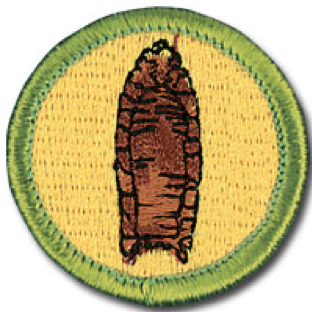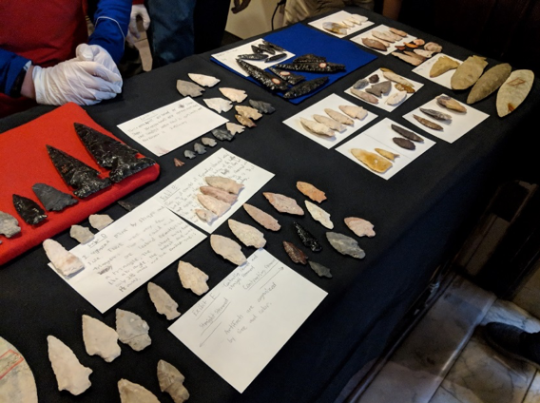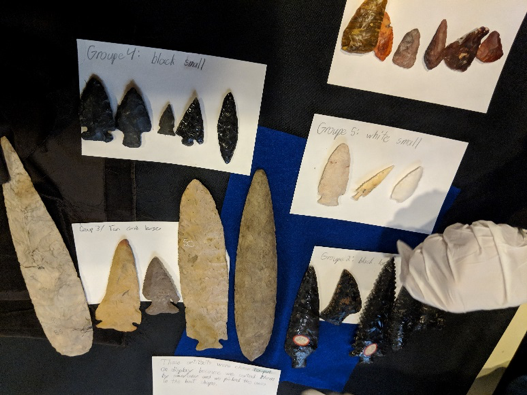by Amy L. Covell-Murthy
The Archaeology merit badge for the Boy Scouts of America was established in 1997. It has a list of eleven different requirements that must be fulfilled before receiving the recognition and patch. The first seven requirements ask the Scout to research archaeology and then answer a long list of questions. These questions include everything from what archaeology is to the difference between absolute and relative dating of sites. They are required to research five separate sites, learn about laws that protect archaeological sites, and make a list of household trash that could be interpreted by archaeologists in the future. Needless to say, this badge is no joke! I have supervised nearly forty college students in my time here at the museum and I think that every one of them would be challenged by the requirements of this badge.

Requirement numbers eight and nine are where we came in to the process:
“8. With your counselor’s approval, take part in a simulated archaeological project designed by a qualified archaeologist. The project must include the use of a simulated archaeological site including artifacts and features for the site. Using the steps of archaeological inquiry, analyze the “artifacts and features” and document the spatial relationships of the “artifacts and features” at the simulated site. Explain how the environment and time can affect the interpretation of an artifact and the overall archaeological site. Tell how you would share the results of your analysis with other researchers and the public
Note: To find out how to make a simulated archaeological site, talk with a professional archaeologist, trained avocational archaeologist, museum school instructor, junior high or high school science teacher, advisor from a local archaeology society, or other qualified instructor.
9. Help prepare an archaeological exhibit for display in a museum, visitor center, school, or other public area.”

Phillip Mendenhall is a member of our Natural History Interpreter staff, a volunteer in the Section of Anthropology, a graduate student at the University of Pittsburgh, and a professional archaeologist who has excavated all over the world. To achieve requirement eight, he created a simulated archaeological project in one of the basement classrooms, using dig boxes and artifacts. The Scouts could dig and screen the dirt and map out the features that they discovered. He made a fun learning environment and really taught the Scouts the intricacies of the archaeological process.
I had the pleasure of helping them achieve requirement nine. With the help of Tamara Alchoufete, my work study student from Pitt, and Shari Bechtel, a delightful CMNH Interpreter, we made two large piles of man-made objects. The objects were donated to the museum many years ago, but lack any proper provenance. These unaccessioned teaching tools were sorted by the Scouts into mini exhibits on a large cart and wheeled from the Resource Room outside of Polar World into the public space. The Scouts were organized into four groups of ten. We repeated the same exercise twice before lunchtime and twice after. Each group was accompanied by several Scout leaders and parents. They seemed just as interested as the participants.

They organized the objects by typology, which in archaeology simply means they are classified by their physical characteristics. They made label copies on index cards, describing the objects and their classifications. Once the mini exhibits were wheeled into the museum’s public space, the Scouts entertained questions from patrons. They had grouped the artifacts into categories by color, size, shape, and material. Each Scout was proud of their own mini exhibit and was very excited to tell people about why they had chosen those objects. Some Scouts talked about different stem shapes, while some had discovered all the obsidian tools. Some Scouts went so far as to measure each object and work together as a four-person group to make a cohesive exhibit that flowed nicely from one Scout to the next.

It was a whirlwind of a day and we received excellent feedback from the participants. Seeing the transition from fun to science, as soon as I asked them to put on their rubber gloves, was incredible. Each and every Scout asked relevant questions and made calculated decisions about how to curate their exhibit. It was so fascinating to see their choices and reasoning. I appreciated every unique decision and every kid who asked additional questions about manufacturing techniques and possible cultural groups or time frame. I would like to think that they had the most fun, but I honestly can’t wait to do it again next year!
Amy L. Covell-Murthy is the Archaeology Collection Manager at Carnegie Museum of Natural History. Museum employees are encouraged to blog about their unique experiences and knowledge gained from working at the museum.
